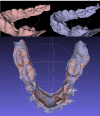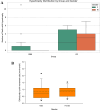Effect of led photobiomodulation on tooth movement, gingival hypertrophy and pain in response to treatment with fixed orthodontic appliance
- PMID: 40249460
- PMCID: PMC12008064
- DOI: 10.1007/s10103-025-04444-5
Effect of led photobiomodulation on tooth movement, gingival hypertrophy and pain in response to treatment with fixed orthodontic appliance
Abstract
Photobiomodulation (PBM) is a form of treatment that uses low-power red and near-infrared light to stimulate tissue repair and regeneration at the cellular level. 32 subjects (198 teeth examined), 10 males and 22 females aged 14.6 ± 2.0 years, with mild dental crowding were included in a randomised, controlled clinical trial. The patients were treated with a fixed orthodontic appliance (FOA). Subjects were randomised into an experimental group (a PBM group irradiated with an LED light source with wavelengths of 625 nm, 660 nm and 850 nm simultaneously and an irradiance of 16 mW/cm²) and a placebo control group that received non-therapeutic irradiation with visible light. PBM therapy began within the first 2 days of appliance insertion and was administered twice weekly for 4 weeks. The rate of tooth movement (a change in distance at the same selected point on the occlusal plane of the tooth determined by measurements on 3D models), the presence of gingival hypertrophy (with a free gingival margin of at least 1 mm occlusal to the enamel-cement junction), the plaque index (PI), the sulcus bleeding index (SBI) and the subjective pain sensation using the visual analogue scale (VAS) were monitored. In the experimental PBM group (N = 14), the rate of movement with the FOA was statistically significantly higher at both 1 week of placement (0.5 mm [95%CI: 0.4-0.8]) and 4 weeks (1.1 mm [95%CI: 0.8-1.4]) than in the placebo group (N = 18), where the values were (0.4 mm [95%CI: 0.2-0.5]) at 1 week and (0.6 mm [95%CI: 0.4-0.9]) at 4 weeks. A lower incidence of gingival hypertrophy was observed in the PBM group (21.4%) than in the placebo group (55.6%) after 4 weeks (Mann-Whitney U-test, p < 0.05). PBM with LED accelerated orthodontic tooth movement during the levelling and alignment phase and reduced the incidence of gingival hypertrophy.
Keywords: Gingival hypertrophy; Orthodontic tooth movement; Pain; Photobiomodulation.
© 2025. The Author(s).
Conflict of interest statement
Declarations. Human ethics and consent to participate declarations: The Clinical trial was conducted in accordance with the Declaration of Helsinki and Declaration of Oviedo. The National Medical Ethics Committee of Slovenia (KRSME) approved the study under reference number 0120–566/2021/6. Clinical trial number: not applicable. All participants and their parents or legal guardians, in the case of minors, were informed about the study and signed a consent form. Competing interests: The authors declare no competing interests.
Figures






References
-
- Masella RS, Meister M (2006) Current concepts in the biology of orthodontic tooth movement. Am J Orthod Dentofac Orthop 129(4):458–468. 10.1016/j.ajodo.2005.12.013 - PubMed
-
- Goncalves CF, Desidera AC, do Nascimento GC, Issa JP, Leite-Panissi CR (2016) Experimental tooth movement and photobiomodulation on bone remodeling in rats. Lasers Med Sci 31(9):1883–1890. 10.1007/s10103-016-2064-y - PubMed
Publication types
MeSH terms
Grants and funding
LinkOut - more resources
Full Text Sources
Research Materials
Miscellaneous

